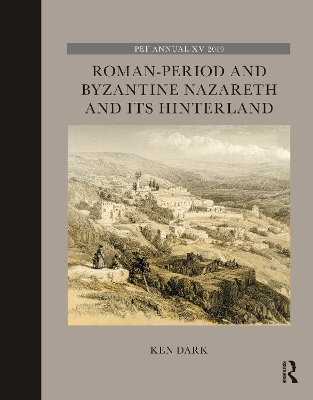The Palestine Exploration Fund Annual
2 total works
Roman-Period and Byzantine Nazareth and its Hinterland presents a new social and economic interpretation of Roman-period and Byzantine Nazareth and its hinterland as a whole, showing the transformation of a Roman-period Jewish village into a major Byzantine Christian pilgrimage centre.
Although Nazareth is one of the most famous places in the world, this is the first book on Roman-period and Byzantine Nazareth by a professional archaeologist, the only book to consider the archaeology of Nazareth in the context of its adjacent landscape, and the first to use contemporary archaeological methods and theory to explore Nazareth’s archaeology. Taking as his starting point a systematic survey of the valley between Nazareth and the Roman town of Sepphoris, Dark offers an interpretation of communities elsewhere in the Roman world as networks of interlocking cells, with interactions along routeways being more important in cultural and economic terms than the relationship between urban centres and their surrounding countryside. His conclusions have implications for the wider archaeology of the Roman and Byzantine worlds, as well as for archaeological theory, and demonstrate the importance of Nazareth to world archaeology.
This unique book will be invaluable to those interested in Nazareth and its surrounding landscape, as well as to archaeologists and scholars of the Roman and Byzantine worlds.
This book transforms archaeological knowledge of Nazareth by publishing over 80 years of archaeological work at the Sisters of Nazareth convent, including a detailed re-investigation in the early twenty-first century under the author's direction.
Although one of the world's most famous places and of key importance to understanding early Christianity, Nazareth has attracted little archaeological attention. Following a chance discovery in the 1880s, the site was initially explored by the nuns of the convent themselves - one of the earliest examples of a major programme of excavations initiated and directed by women - and then for decades by Henri Senes, whose excavations (like those of the nuns) have remained almost entirely unpublished. Their work revealed a complex sequence, elucidated and dated by twenty-first century study, beginning with a partly rock-cut Early Roman-period domestic building, followed by Roman-period quarrying and burial, a well-preserved cave-church, and major surface-level Byzantine and Crusader churches. The interpretation and broader implications of each phase of activity are discussed in the context of recent studies of Roman-period, Byzantine, and later archaeology and contemporary archaeological theory, and their relationship to written accounts of Nazareth is also assessed.
The Sisters of Nazareth Convent provides a crucial archaeological study for those wishing to understand the archaeology of Nazareth and its place in early Christianity and beyond.

